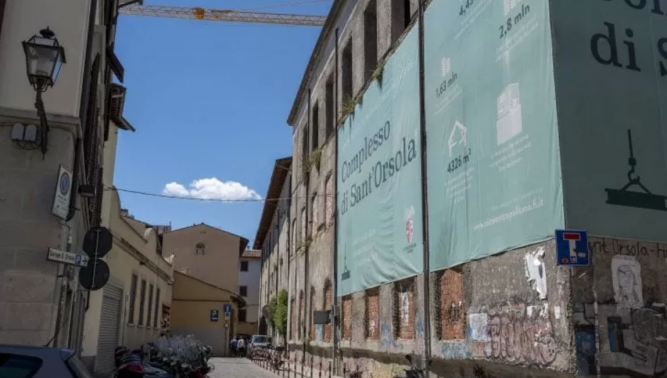A New Life for Sant’Orsola in San Lorenzo

The former convent of Sant’Orsola turned tobacco factory in 1810 will be renovated by the French group Artea beginning in 2022. By the close of the project between 2024 and 2025, the site owned by the Municipality since 2004 will become the new artistic and social hub of the San Lorenzo district. Located near the Church of San Lorenzo and the open air markets, Sant’Orsola has long been a dilapidated set of buildings but Artea’s designs promise a new life for the space.
Artea plans to reimagine the decades-abandoned complex into an international school of hospitality, a business center, and an arts district. The 17,000 square meters (nearly 183,000 square ft.) will host artisan shops, restaurants, and public spaces for events. Artea has invested 31.5 million euros into the project which will officially start construction next year. Philippe Baudry, CEO of the Artea group, says the project will be sustainable and 100% Florentine. Mayor Dario Nardella expresses his excitement about the final design and promises that there will be no hotels or shopping centers built on the property. Instead, the former convent and factory will host an education and conference center, co-working spaces, a bar, library, and wellness center.
However, the design plan will still honor the history of the property. Since the convent was built in 1309, Sant’Orsola has taken on many hats from a tobacco factory to a refugee camp for Italians fleeing from Yugoslavia in the aftermath of World War II. Although there has been talk in the past about converting the space into barracks for the finance police, Sant’Orsola has taken on an almost phantom presence in San Lorenzo. The community cares about the area and had Artea not stopped forward with a proactive design plan, it would probably eventually crumble into the cobblestones of the city.
Sant’Orsola, however, will have its own Renaissance. The courtyard will be turned into a public space and the structure which once housed the tobacco factory will host a museum. Meanwhile, the two churches on the property will be enhanced and open to the public during the day so visitors may still visit the probable tomb of Lisa Gherardini, Leonardo da Vinci’s Mona Lisa who spent her last years with the nuns of the convent. As Nardella makes clear, Florence is at a turning point of bridging Florence’s past with its future, sustainable architecture, and hope for a rebirth of Sant’Orsola that welcomes innovation and design. (elizabeth berry)
To read more in Italian, visit Florence’s La Repubblica news site.
